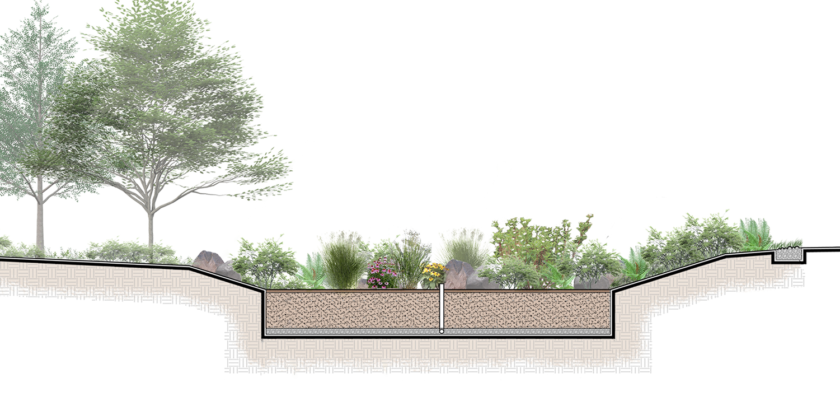Protecting & Restoring Long Island's Peconic Bays

Rain gardens, or bioretention systems, are shallow depressions where stormwater is directed toward through a downspout, gutters, or grassy or stone swale, that include a mulched planting area to capture stormwater and provide groundwater recharge and pollutant treatment. Nitrogen removal occurs through a number of processes including adsorption, filtration, volatilization, ion exchange, nutrient uptake, and decomposition (USEPA 1999). Rain gardens are most commonly used in residential settings to treat small volumes of stormwater (NYS 2015) while bioretention systems can capture and treat larger volumes in municipal or institutional settings using the same design features (USEPA 1999). Landscape design is flexible but design features can have a large impact on their effectiveness (Ly and Rameriz-Avila 2018) and thus professional design consultation or use of available online resources (e.g., https://nemo.uconn.edu/raingardens/index.htm) is recommended.
The creation of stormwater management systems is largely dependent on availability of land. In addition to locating Rain gardens should be placed at least 10 feet away from basement foundations, on relatively flat slopes to allow filtering or employ berms or retaining walls on moderate slopes. Vegetated surfaces surrounding raingardens should be kept to a minimum to maximize treatment of stormwater from impervious surfaces (NYS 2015). Soil composition should consist of 50% to 70% sand, 50% to 30% topsoil, 5% organic matter, and less than 5% clay content (NYS 2015). The total contributing area of a rain garden should be less than 1,000 square feet; larger systems need to follow bioretention design elements (NYS 2015).
In New York State, stormwater collection systems must follow a five-step process (NYS 2015):
Detailed information on the SPDES permit requirements for SMPs are available on the NYSDEC website at https://www.dec.ny.gov/chemical/8468.html.
Permits are not required for rain gardens, but the following may be required for larger bioretention systems:
The Peconic Estuary Partnership (PEP) is promoting the installation of rain gardens with a Homeowners Rewards Program where homeowners can receive up to a $500 rebate. The Suffolk County Water Improvement Division Quality promotes stormwater quality improvements through the Water Quality Protection and Restoration Program and Land Stewardship Initiatives (WQPRP) grant funding program. New York State provides funding through the Water Quality Improvement Project (WQIP) Program.
The nitrogen removal effectiveness of rain gardens varies widely and largely depend on soil type and design configuration; the highest nutrient removal rates occur in gardens that optimize infiltration rates or systems that are installed with an internal water storage system (Ly and Rameriz-Avila 2018). Additionally, soil disturbance, and installation of an underdrain (Dietz and Clausen 2005) and the addition of thick mulch layers (Brown and Hunt 2011) could inhibit rain garden performance.
The rain garden BMP includes both rain gardens and bioretention systems. The rain garden scenario is based on a 50-square-foot installation on residential lot with average impervious cover of 14% (NYS 2015) and the 1:6 raingarden:watershed ratio recommended by the University of Connecticut Nonpoint Education for Municipal Officials (NEMO; https://nemo.uconn.edu/raingardens/index.htm). The bioretention scenario considers a 1-acre system draining a 25-acre watershed with an average impervious cover of 37% (Chesapeake Bay Program 2020). The nitrogen removal efficiency range for both scenarios is an average of the studies summarized by Ly and Rameriz‑Avila (2018) that included internal water storage and did not contain an underdrain (Dougherty et al. 2017; Brown and Hunt 2011; DeBusk and Wynn 2011; Hunt et al. 2006). An influent nitrogen concentration of 2.0 mg/L is assumed for both scenarios.
Rain Garden Nitrogen Effluent Concentrations, Nitrogen Reduction, Drainage Area and Annual Removal Rates
| BMP | Effluent Nitrogen Concentration (mg/L) | Nitrogen Reduction (%) | Drainage Area (acres) | Annual Nitrogen Removal (lb/yr) |
|---|---|---|---|---|
| Rain Garden* | 1.0 | 50 | 0.007 | 0.01 |
| Bioretention System | 1.0 | 50 | 25 | 105 |
The rain garden lower bound capital cost includes $500 for a 50-square-foot installation (PEP, personal communication) and the upper bound cost also includes $400 for design costs (4 hours at $100 per hour). Rain garden O&M costs include $50 per year for mulching and planting. Bioretention capital and O&M costs are for a 1-acre installation and lower and upper bound costs are based on the average of cost estimates included in CAST (Chesapeake Bay Program 2020) for a bioretention system with no underdrain for a new/redevelopment and a retrofit installation, respectively. The annualized total cost includes capital costs that are adjusted to a per acre treated basis by multiplying by the impervious cover assumptions and are annualized over a 23-year lifespan (average of bioretention systems included in CAST) with a 5% discount rate and the annual average O&M cost with a 2% interest rate applied.
Rain Garden Capital, O&M, Total Annualized Costs, and Costs per Pound of Nitrogen Removed
| BMP Type | Capital Cost | Average Annual O&M Costs | Annualized Total Cost | Cost per Pound N Removed |
|---|---|---|---|---|
| Rain Garden* | $500–$900 | $63 | $14–18 | $1,387–$1,812 |
| Bioretention System | $38,108–$76,215 | $5,199 | $3,002–$5,058 | $29–$39 |
Sign up for News, Events and Information straight to your inbox.
